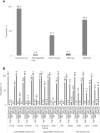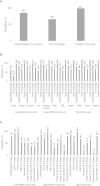Food Group, Macronutrient Intake, and Metabolic Status in the US-Affiliated Pacific's Children's Healthy Living (CHL) Program
- PMID: 35927738
- PMCID: PMC9839993
- DOI: 10.1093/jn/nxac173
Food Group, Macronutrient Intake, and Metabolic Status in the US-Affiliated Pacific's Children's Healthy Living (CHL) Program
Abstract
Background: The Children's Healthy Living study provided dietary intake information for understudied Native Hawaiian and Other Pacific Islander (NHOPI) young children.
Objectives: Our objective was to describe food group and macronutrient intakes of NHOPI children in the US-Affiliated Pacific region (USAP), overall and by jurisdiction, income level, and metabolic status.
Methods: We evaluated 2-8-y-olds (n = 3520) in a cross-sectional cluster sampled study using 2 d of dietary records completed by caregivers using provided tools, quantified by a specially developed food composition table and compared with US dietary recommendations. Overweight and obesity (OWOB) and acanthosis nigricans (AN) assessment (metabolic status) was completed by trained evaluators using standard tools. Demographic data were collected by questionnaire. Regression analysis identified differences in dietary component means by jurisdiction, World Bank income groups (WBIGs), and metabolic status, adjusted for age and sex.
Results: Few children met US recommendations for vegetable (2.4%) and milk (4.1%) food groups. US macronutrient recommendations were generally met. Food group and macronutrient intakes were significantly different by jurisdiction and WBIG. Means for food groups, except meats, and macronutrients, except protein, were higher in overweight/obese (OWOB) compared with healthy-weight children. Grain intake of 7.25 (SE: 0.08) oz was higher (P < 0.05) and milk intake of 0.90 (SE: 0.05) cups was lower (P < 0.05) in children with OWOB compared with those without OWOB [grains: 7.17 (SE: 0.07) oz; and milk: 0.96 (SE: 0.04) cups]. Monounsaturated fat intake of 11.68 (SE: 0.10) % energy was higher in those with OWOB, compared with healthy-weight children [11.56 (SE: 0.08) % energy, P < 0.05].
Conclusions: Young children's diets in the USAP did not meet milk, vegetable, or fruit intake recommendations. There was variability in dietary patterns across the USAP and by WBIG. Grain intake and monounsaturated fat intake were lower and milk intake was higher in children with better metabolic status.
Keywords: Pacific; children; food group; nutrient; obesity.
© The Author(s) 2022. Published by Oxford University Press on behalf of the American Society for Nutrition.
Figures



Similar articles
-
Diet Quality of Young Children in the US-Affiliated Pacific's Children's Healthy Living (CHL) Program.J Acad Nutr Diet. 2023 Dec;123(12):1781-1792. doi: 10.1016/j.jand.2023.08.003. Epub 2023 Aug 9. J Acad Nutr Diet. 2023. PMID: 37562772 Free PMC article.
-
Prevalence and Predictors of Overweight and Obesity among Young Children in the Children's Healthy Living Study on Guam.Nutrients. 2020 Aug 20;12(9):2527. doi: 10.3390/nu12092527. Nutrients. 2020. PMID: 32825433 Free PMC article.
-
Maintenance Outcomes of the Children's Healthy Living Program on Overweight, Obesity, and Acanthosis Nigricans Among Young Children in the US-Affiliated Pacific Region: A Randomized Clinical Trial.JAMA Netw Open. 2022 Jun 1;5(6):e2214802. doi: 10.1001/jamanetworkopen.2022.14802. JAMA Netw Open. 2022. PMID: 35666503 Free PMC article. Clinical Trial.
-
Food intake regulation in children. Fat and sugar substitutes and intake.Ann N Y Acad Sci. 1997 May 23;819:194-220. doi: 10.1111/j.1749-6632.1997.tb51809.x. Ann N Y Acad Sci. 1997. PMID: 9186769 Review.
-
Using the ANGELO model to develop the children's healthy living program multilevel intervention to promote obesity preventing behaviors for young children in the U.S.-affiliated Pacific Region.Child Obes. 2014 Dec;10(6):474-81. doi: 10.1089/chi.2014.0102. Child Obes. 2014. PMID: 25369548 Free PMC article. Review.
Cited by
-
Diet Quality of Young Children in the US-Affiliated Pacific's Children's Healthy Living (CHL) Program.J Acad Nutr Diet. 2023 Dec;123(12):1781-1792. doi: 10.1016/j.jand.2023.08.003. Epub 2023 Aug 9. J Acad Nutr Diet. 2023. PMID: 37562772 Free PMC article.
-
Prevalence and socio-demographic distributions of meeting RMI Guidelines for Healthy Living among elementary school children in Majuro, Republic of Marshall Islands: a cross-sectional population-based survey.Lancet Reg Health West Pac. 2023 May 3;37:100783. doi: 10.1016/j.lanwpc.2023.100783. eCollection 2023 Aug. Lancet Reg Health West Pac. 2023. PMID: 37693881 Free PMC article.
-
Food Security is Associated with Higher Diet Quality Among Children of the US-Affiliated Pacific Region.J Nutr. 2023 Mar;153(3):848-856. doi: 10.1016/j.tjnut.2023.01.015. Epub 2023 Jan 13. J Nutr. 2023. PMID: 36775673 Free PMC article.
References
-
- The Nationwide Food Consumption Survey (NFCS), 1977–78. [Internet]. Beltsville (MD): U.S. Department of Agriculture, Agricultural Research Service, Beltsville Human Nutrition Research Center and Food Surveys Research Group. [cited August 17, 2022]. Available from: https://www.ars.usda.gov/ARSUserFiles/80400530/pdf/77nfcs.pdf
-
- U.S. Department of the Interior . Compacts of free association. [Internet]. 2015; [cited September 12, 2021]. Available from: https://www.doi.gov/oia/compacts-of-free-association
-
- World Bank . World Bank income classification. [Internet]. [cited September 12, 2021]. Available from: http://chartsbin.com/view/2438
-
- World Health Organization . Diet, food supply and obesity in the Pacific. [Internet]. WHO Regional Office for the Western Pacific; 2003; [cited September 9, 2020]. Available from: https://apps.who.int/iris/handle/10665/206945
Publication types
MeSH terms
Grants and funding
LinkOut - more resources
Full Text Sources
Medical
Miscellaneous

